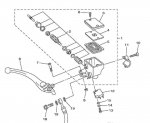So I was out for a ride today and long story short, took a turn too fast and laid bike down on the left side. There was no substantial damage, only a bent bar-end on the left side and some scratches. I killed the engine as soon as I could and then stood the bike back up and put down the kick stand. I dusted myself off, gave the bike a good look over and everything seemed fine, phew. I hopped on it, started down the road going slow to make sure it wasn't going to fall apart and the first turn I got to, I went to hit the brakes and there was no pressure in the front lever at all....so I pulled over, and stopped and magically the pressure came back... I lifted the front wheel off the ground and spun it by hand and tried to squeeze the lever and it was limp, let the wheel stop and the lever is firm again instantly.
So it looks like the front brake only works while the front wheel is stopped. Thoughts?
So it looks like the front brake only works while the front wheel is stopped. Thoughts?
Last edited:

